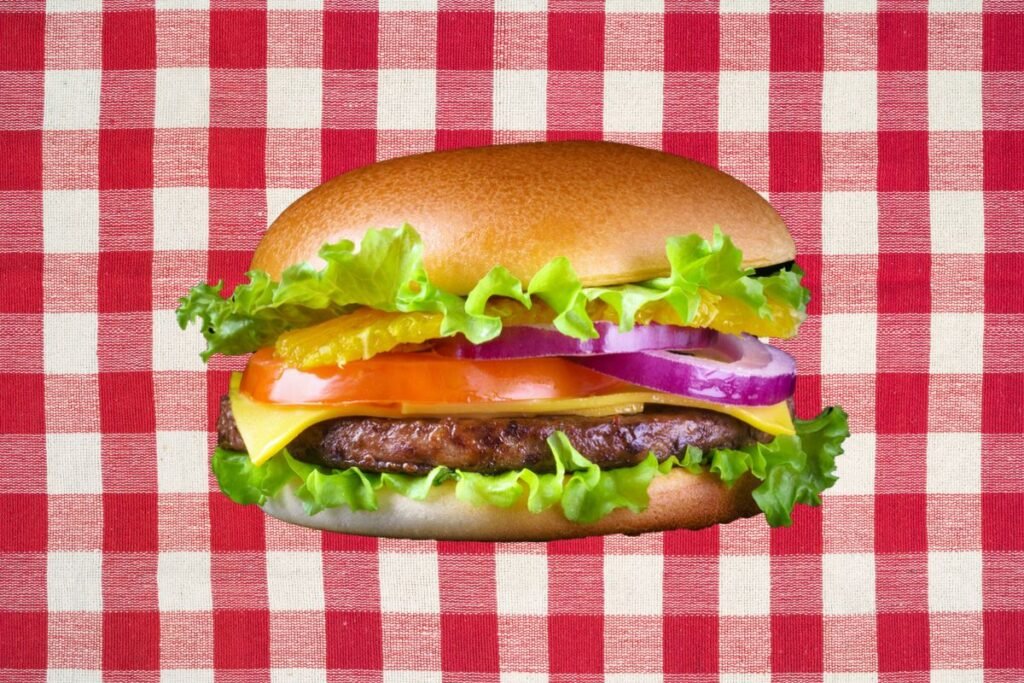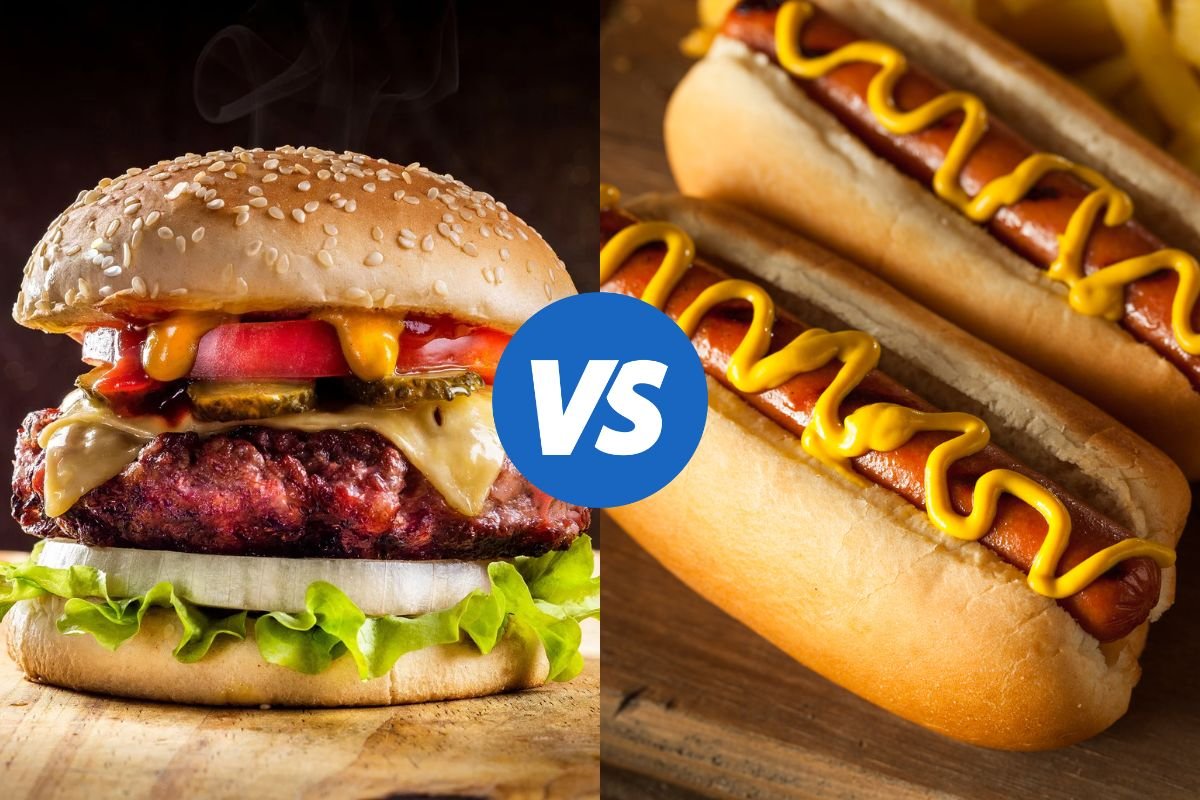When it comes to iconic American foods, hamburgers and hotdogs are at the top of the list.
Whether it’s a Fourth of July bar-b-que or ordering from your favorite fast food restaurant, these foods are found all over the place. From ballparks to backyards, everyone loves hamburgers and hotdogs.
Hotdog Vs Hamburger
Hamburgers are ground beef made into patties and served on a bun made explicitly for hamburgers. Choice of fixings usually includes lettuce, tomatoes, onions, and pickles. Hotdogs are pork, beef, and/or chicken sausage made without casing and served on a partially sliced bun. Hotdogs are often topped with mustard ketchup and pickle relish.
Both can be made in a variety of ways to suit almost any taste. I know that I rarely eat a hamburger without the cheese. We’re going to take a closer look at these two popular American foods as far as their similarities, differences, nutrition, and more.
Hamburgers and Hotdogs in History
The invention of the hamburger is in dispute. And, likewise, the hotdog doesn’t have one clear inventor. The actual piece of sausage, besides being known as a hotdog, is also called a weiner or frankfurter, and even still, just a frank.
Another thing the two have in common is that they are “to go”. As travel options ramped up with the invention of motorized vehicles around the turn of the twentieth century, foods were prepared differently to accommodate people on the move.
Both Frankfurt Germany and Vienna claim to have had their version of the hotdog for hundreds of years. But the term “hotdog” is as American as apple pie.
The hamburger also has roots in Germany, taking its name from Hamburg. Another American original that found shape around the same time as the hamburger is the Salisbury steak.
Now that we know a little about the origins of the hamburger and the hotdog, let’s get to the important stuff.

Which Tastes Better Hamburger or Hotdog?
Americans consume between 8 and 10 billion hotdogs a year. They can be cooked on the grill, made into chili dogs, or served a hundred other ways. Their easy preparation and availability make them a favorite for families with kids.
What makes hotdogs irresistible is the variety of toppings that can be added. Although, these toppings are usually packed with calories and, like the hotdog itself, are less nutritional than many foods including the hamburger. But more on that later!
Not to be outdone, the hamburger is one very popular food, selling nearly 50 billion a year in the U.S. alone. Besides the traditional toppings, hamburgers can be loaded in a variety of ways.
Cheese and bacon are two of my favorites. But there is something to be said for the chili-cheese burger as well. Grilled or fried, hamburgers are delicious almost any way you make them. Many kids want just a plain hamburger with no sauces, and that’s ok!

Which Costs More Hot Dogs or Hamburgers?
One of the most appealing things about the hotdog since its inception has been its price. The inclusion of hotdog stand ads in college magazines in the 1890s is a testament to its economical price.
Hotdogs are sold in different size packages and can be bought at any grocery store, for anywhere between $1.48 per pound all the way up to $9.92 per pound.
Hamburgers for dinner will not break the bank either. Ground beef, commonly referred to as hamburger meat, starts from about $3 per pound for unprepared, packaged meat.
Ground beef from grass-fed cows starts at around $7 per pound. Pre-cooked, frozen burgers come in at around $8 dollars a pound.
At a restaurant (fast food or otherwise) A hot dog is going to cost you around $3.25 apiece. A pretty good profit for someone in the hotdog business.
The average price for a hamburger at a restaurant is $6.25 to $9.50 depending on where you live. Compare that to making them yourself at home for about $2.50 apiece.
Hamburger Vs Hotdog Comparison Chart
| Hamburger | Hotdog |
| Hamburger is made from 100% lean, ground beef. | Hotdogs are made from trimmings of beef, pork, and chicken. |
| Hamburgers come packaged with different fat content. | Hotdogs have almost twice the fat and sodium of hamburgers |
| Hamburgers are round patties. | Hotdogs are oblong sausages. |
| Red meat is a probable carcinogen. | Processed smoked meats, like hotdogs, are definite carcinogens. |
Hamburger Vs Hot Dog Nutrition
Let’s face it, neither hotdogs nor hamburgers are going to win any awards for nutrition. Let’s take a look at their nutritional values. Values represented are plain with a bun.
| Hamburger Nutritional Values | Hot dog Nutritional Values |
| Calories – 459 | Calories – 250 |
| Fat – 23.18g | Fat – 14.98 |
| Sodium – 613mg | Sodium – 717mg |
| Protein – 28.47g | Protein – 9.06g |
Which is Healthier Hamburger Vs Hotdog
Both hamburgers and hotdogs are high in saturated fat, and both are considered carcinogens, but processed meat like that found in the hotdog, if eaten once a day, can increase colon cancer risk by 18%.
The caloric breakdown of hamburgers and hotdogs goes something like this: hamburgers are 46% fat, 28% carbs, and25% protein while hotdogs are 55% fat, 31% carbs, and 15% protein.
So while neither is the preferred choice when trying to stay on a healthy diet, the hamburger is pound for pound the better choice. Another way the hamburger beats the hot dog nutritionally is the choice of healthier options when it comes to cooking and serving hamburgers.
Eating it open-faced without the bun saves you 110 calories, over a gram of fat, and 20 grams of carbohydrates. You can also choose leaner meat and serve it with healthy toppings like avocado and vegetables.
Love food as much as we do? Check out these articles:
Conclusion
When given the option of hamburgers or hotdogs, I will almost always choose hamburgers, or in a perfect scenario, I would choose both! That being said, at some restaurants, I just don’t care for the hamburger and will opt for a hotdog, with chili and cheese preferably.
When barbequing at home I will usually have one of each. Both are tasty and not bad meal options when eaten in moderation.


